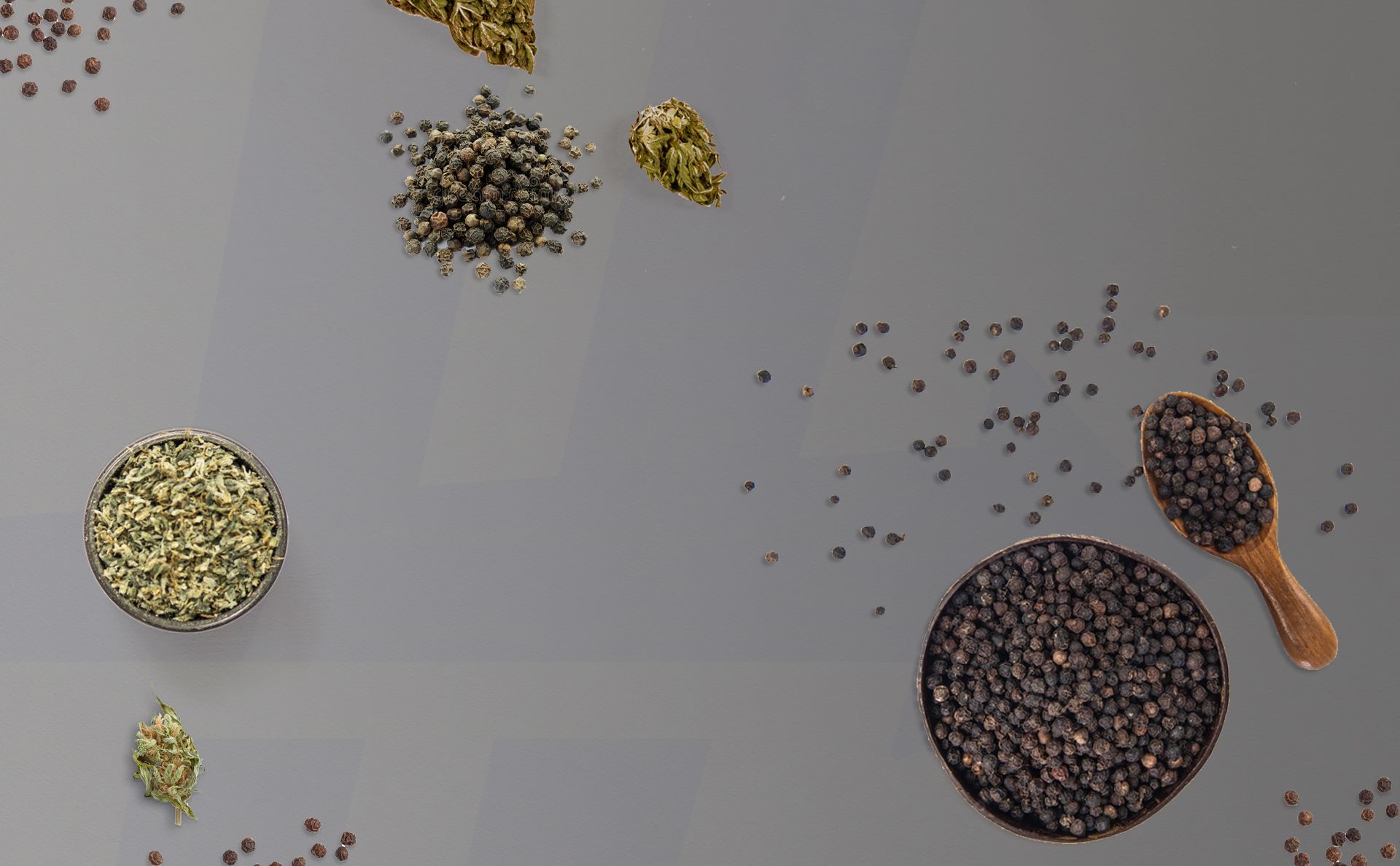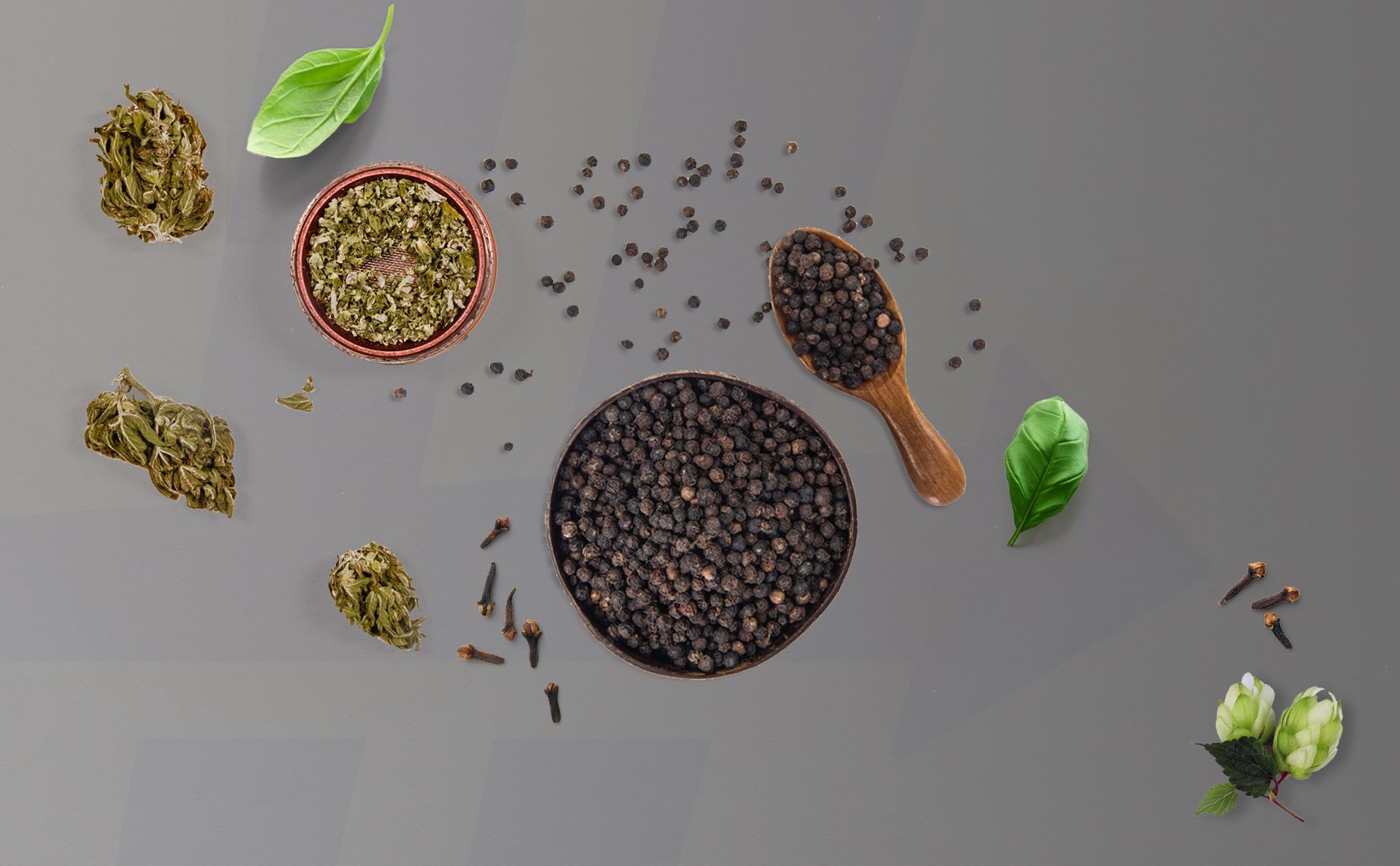Caryophyllene
In this chapter, we discuss the spiciest of all terpenes, caryophyllene. Where does this unique terpene show up in cannabis, and what are its benefits? Read on for more.

In this chapter of our terpene guide, we cover caryophyllene. This is a robust, spicy terpene with notes of woody flavors. Which plants contain caryophyllene? What are its flavors and aromas like, and what are some potential benefits? Read on for more.
If you are new to the wonderful world of Terpenes, be sure to educate yourself properly by checking out our “What are Terpenes?” chapter of our Terpenes Guide.
What is Caryophyllene?
Pronounced Carry-Oh-Fee-Lean, the terpene caryophyllene is the spiciest of these compounds. Caryophyllene is a robust and pungent terpene that is found in spices and herbs like black pepper, basil, cinnamon, and oregano.
Caryophyllene is the only terpene that can also act as a cannabinoid – but it doesn’t get you high. By only interacting with the CB2 receptor of the endocannabinoid system (ECS), caryophyllene may offer pain-relieving and anti-inflammatory benefits without psychoactive effects.
Like other cannabinoids and terpenes, caryophyllene also has many targets beyond the ECS that add many other potential benefits. Because it’s abundant in cannabis and food, it’s also dubbed a “dietary cannabinoid.”
Are Beta-Caryophyllene and Caryophyllene the Same?
Beta-Caryophyllene and Caryophyllene are the same, and sometimes used interchangeably. The “beta” refers to a unique structural arrangement of caryophyllene. Basically, it’s by far the most common shape of caryophyllene with the most research and therapeutic interest.
The molecular formula of caryophyllene is the same, but different kinds of caryophyllene have their own individual structural differences with the same chemical formula. Compounds like these with the same formula, but in different shapes, are called isomers. The subtle differences between caryophyllene isomers tend to only show up in any meaningful detail in lab tests and studies that show how rare the other isomers are.

What the expert says...
Dr. Abraham Benavides
"Often referred to as the “spicy terpene,” caryophyllene is the only such compound that can also act as a cannabinoid."
Terpene Flavor and Aroma Profile: Caryophyllene
Caryophyllene is a terpene that lends itself to the pungent bite and robust flavors in many foods, spices, herbs, oils, hemp, and plants in our natural world. These include cloves, hops, rosemary, and basil. If you’ve ever been delighted by the scent of freshly ground black pepper, you have caryophyllene to thank for that.

Cultivars with Caryophyllene
In cannabis, caryophyllene is a dominant terpene in many cultivars. Where it lends itself to pungent, peppery flavors like those with Cookies, Diesel, White, Glue, and Chemdawg lineage. Some of the most popular cultivars that contain caryophyllene include Bubba Kush, Sour Diesel, and GSC.
Of note is a special cultivar called Cayodiol™. As you might guess by the name, it’s selectively bred for its high caryophyllene and cannabidiol (CBD) content. This type III cultivar (CBD-dominant) is also known as “Kashmir Blue.”
Does Caryophyllene Get You High?
Recent research suggests certain terpenes may be slightly psychoactive, but caryophyllene will not get you high when consumed on its own. To do that, terpenes need to appreciably activate the CB1 receptor like THC does, and so far other terpenes show 10-50% the activity of THC.
Rather, caryophyllene targets the CB2 receptor exclusively, meaning it won’t cause a high but instead give direct anti-inflammatory and immune-modifying actions. Terpenes like caryophyllene also make a larger impact in our bodies known as the entourage effect, which essentially describes the nuances of how whole-plant cannabis compounds make us feel.
Potential Benefits of Caryophyllene
Caryophyllene directly impacts the endocannabinoid system in humans, and is actually the only terpene we know of that also acts as a cannabinoid. This is due to caryophyllene’s unique ability to bind to the body’s CB2 receptors of the endocannabinoid system.
Studies have shown that caryophyllene has many wide-ranging potential benefits. This terpene can possibly offer pain relief and may help consumers reduce their alcohol intake. Future applications of caryophyllene may lead to this terpene being utilized to treat addiction, including substance abuse of:
- Alcohol
- Cocaine
- Nicotine
- Opioids
Additionally, preliminary research suggests that caryophyllene acts as an anti-inflammatory and antioxidant, which may help patients with inflammatory conditions, chronic liver disease, bowel ailments, and more. Due to the impact caryophyllene has on non-CB receptors outside the endocannabinoid system, the terpene may help with symptoms of anxiety and depression.
Beta-caryophyllene may also have other potential therapeutic properties, including:
- Gastroprotective
- Pain-relieving
- Anti-arthritic
- Anticancer and chemosynergy effects
- Antifungal and antibacterial
- Promote muscle recovery (DOMS)
- Antimalarial
- Neuroprotective and antiepileptic
What’s more, the consumption of foods and substances containing caryophyllene may even help to prolong your lifespan. Early animal studies show beta-caryophyllene extended the lifespan of C. elegans by over 22%, which is promising but still a bit far from humans. The rationale is that this spicy terp can reduce proinflammatory gene stress, which could lead to the therapeutic potential of being an eventual aid in anti-aging.
What We Learned: Caryophyllene
Caryophyllene is just one of the many unique terpenes found in cannabis and our natural world. Early clinical and animal research is promising, but large clinical research is necessary to determine how effective these potential benefits are. Here’s what we learned in our caryophyllene chapter:
- Some call caryophyllene the spicy terpene, because of its robust and pungent nature, and the fact that it is found in spices like black pepper, cinnamon, and oregano.
- Caryophyllene is the only terpene that can also act as a cannabinoid. Interacting with only the CB2 receptor endocannabinoid system, caryophyllene may offer pain-relieving and anti-inflammatory benefits without an intoxicating high.
- Caryophyllene binds to the body’s other anti-inflammatory receptors outside the endocannabinoid system, too, to increase cannabis’ anti-inflammatory effects.
- Beta-caryophyllene and caryophyllene share the same molecular formula, but different kinds of this terpene do have their own individual structural differences and are in trace quantities.
- Studies show that caryophyllene may be beneficial as a pain reliever, antioxidant, anti-inflammatory, and could help those struggling with substance use disorders, or addiction.
- Some of the most popular cultivars that contain caryophyllene include Bubba Kush, Sour Diesel, and GSC. Caryodiol™ aka Kashmir Blue is a cultivar selectively bred for its uniquely high caryophyllene and CBD content.
More research will likely find more benefits in plants with terpenes like caryophyllene, not just cannabis. The future of the wonderful world of terpenes is here, and HashDash is your educational resource for these invaluable compounds.
Another terpenes chapter is complete! Ready for another? Answer the below chapter question and let's move on to the next.
Citations
- Barré, T., Di Marzo, V., Marcellin, F., Burra, P., & Carrieri, P. (2023). Expanding Research on Cannabis-Based Medicines for Liver Steatosis: A Low-Risk High-Reward Way Out of the Present Deadlock? Cannabis and Cannabinoid Research, 8(1), 5–11.https://doi.org/10.1089/can.2022.0014
- Benavides, A. (2022, June 23). Beta-Caryophyllene—Terpenes and Cannabinoid Research—Cannakeys.https://cannakeys.com/beta-caryophyllene-terpene-research/
- Beta-caryophyllene modulates expression of stress response genes and mediates longevity in Caenorhabditis elegans. (2014). Experimental Gerontology, 57, 81–95.https://doi.org/10.1016/j.exger.2014.05.007
- Cox-Georgian, D., Ramadoss, N., Dona, C., & Basu, C. (2019). Therapeutic and Medicinal Uses of Terpenes. Medicinal Plants, 333–359.https://doi.org/10.1007/978-3-030-31269-5_15
- de Cássia da Silveira e Sá, R., Lima, T. C., da Nóbrega, F. R., de Brito, A. E. M., & de Sousa, D. P. (2017). Analgesic-Like Activity of Essential Oil Constituents: An Update. International Journal of Molecular Sciences, 18(12), 2392.https://doi.org/10.3390/ijms18122392
- Full article: A randomized, double-blind, placebo-controlled, repeated-dose pilot study of the safety, tolerability, and preliminary effects of a cannabidiol (CBD)- and cannabigerol (CBG)-based beverage powder to support recovery from delayed onset musclehttps://www.tandfonline.com/doi/full/10.1080/15502783.2023.2280113
- Hanuš, L. O., & Hod, Y. (2020). Terpenes/Terpenoids in Cannabis: Are They Important? Medical Cannabis and Cannabinoids, 3(1), 25–60.https://doi.org/10.1159/000509733
- Mödinger, Y., Knaub, K., Dharsono, T., Wacker, R., Meyrat, R., Land, M. H., Petraglia, A. L., & Schön, C. (2022). Enhanced Oral Bioavailability of β-Caryophyllene in Healthy Subjects Using the VESIsorb® Formulation Technology, a Novel Self-Emulsifying Druhttps://doi.org/10.3390/molecules27092860
- Oliveira, G. L. da S., Machado, K. C., Machado, K. C., da Silva, A. P. dos S. C. L., Feitosa, C. M., & de Castro Almeida, F. R. (2018). Non-clinical toxicity of β-caryophyllene, a dietary cannabinoid: Absence of adverse effects in female Swiss mice. Regulhttps://doi.org/10.1016/j.yrtph.2017.12.013
- Raz, N., Eyal, A. M., Zeitouni, D. B., Hen-Shoval, D., Davidson, E. M., Danieli, A., Tauber, M., & Ben-Chaim, Y. (2023). Selected cannabis terpenes synergize with THC to produce increased CB1 receptor activation. Biochemical Pharmacology, 212, 115548.https://doi.org/10.1016/j.bcp.2023.115548
- Russo, E. B. (2019). The Case for the Entourage Effect and Conventional Breeding of Clinical Cannabis: No “Strain,” No Gain. Frontiers in Plant Science, 9.https://doi.org/10.3389/fpls.2018.01969
- Siracusa, L., Ruberto, G., & Cristino, L. (2023). Recent Research on Cannabis sativa L.: Phytochemistry, New Matrices, Cultivation Techniques, and Recent Updates on Its Brain-Related Effects (2018–2023). Molecules, 28(8), 3387.https://doi.org/10.3390/molecules28083387
- Tomko, A. M., Whynot, E. G., Ellis, L. D., & Dupré, D. J. (2020). Anti-Cancer Potential of Cannabinoids, Terpenes, and Flavonoids Present in Cannabis. Cancers, 12(7), 1985.https://doi.org/10.3390/cancers12071985
Test your knowledge, track your progress and earn your badge.
Caryophyllene can possibly offer pain relief and may help consumers reduce their alcohol intake.

Dr. Abraham Benavides
Dr. Abraham Benavides is an internationally-recognized cannabis research expert, experienced medical advisor, and full-tuition merit scholar of the George Washington University School of Medicine and Health Sciences. Dr. Abe enjoys helping patients as a writer, educator, and cannabis health coach at the GW Center for Integrative Medicine.